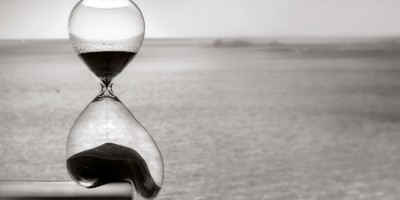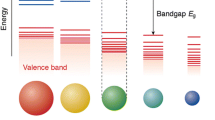Abstract
In contrast to interband excitons in undoped quantum wells, doped quantum wells do not display sharp resonances due to excitonic bound states. The effective Coulomb interaction between electrons and holes in these systems typically leads to only a depolarization shift of the single-electron intersubband transitions1. Non-perturbative light–matter interaction in solid-state devices has been investigated as a pathway to tuning optoelectronic properties of materials2,3. A recent theoretical work4 predicted that when the doped quantum wells are embedded in a photonic cavity, emission–reabsorption processes of cavity photons can generate an effective attractive interaction that binds electrons and holes together, leading to the creation of an intraband bound exciton. Here, we spectroscopically observe such a bound state as a discrete resonance that appears below the ionization threshold only when the coupling between light and matter is increased above a critical value. Our result demonstrates that two charged particles can be bound by the exchange of transverse photons. Light–matter coupling can thus be used as a tool in quantum material engineering, tuning electronic properties of semiconductor heterostructures beyond those permitted by mere crystal structures, with direct applications to mid-infrared optoelectronics.





Similar content being viewed by others
Data availability
The data that support the findings of this study are available from the corresponding authors on reasonable request. Source data are provided with this paper.
Code availability
The codes that support the findings of this study are available from the corresponding author (S.D.L.) on reasonable request.
References
Nikonov, D. E., Imamoğlu, A., Butov, L. V. & Schmidt, H. Collective intersubband excitations in quantum wells: Coulomb interaction versus subband dispersion. Phys. Rev. Lett. 79, 4633–4636 (1997).
Frisk Kockum, A., Miranowicz, A., De Liberato, S., Savasta, S. & Nori, F. Ultrastrong coupling between light and matter. Nat. Rev. Phys. 1, 19–40 (2019).
Forn-Díaz, P., Lamata, L., Rico, E., Kono, J. & Solano, E. Ultrastrong coupling regimes of light-matter interaction. Rev. Mod. Phys. 91, 025005 (2019).
Cortese, E., Carusotto, I., Colombelli, R. & De Liberato, S. Strong coupling of ionizing transitions. Optica 6, 354–361 (2019).
Ballarini, D. & De Liberato, S. Polaritonics: from microcavities to sub-wavelength confinement. Nanophotonics 8, 641–654 (2019).
Khurgin, J. Excitonic radius in the cavity polariton in the regime of very strong coupling. Solid State Commun. 117, 307–310 (2001).
Citrin, D. S. & Khurgin, J. B. Microcavity effect on the electron-hole relative motion in semiconductor quantum wells. Phys. Rev. B 68, 205325 (2003).
Khurgin, J. B. Pliable polaritons: Wannier exciton-plasmon coupling in metal-semiconductor structures. Nanophotonics 8, 629–639 (2018).
Yang, M.-J., Kim, N. Y., Yamamoto, Y. & Na, N. Verification of very strong coupling in a semiconductor optical microcavity. N. J. Phys. 17, 023064 (2015).
Brodbeck, S. et al. Experimental verification of the very strong coupling regime in a GaAs quantum well microcavity. Phys. Rev. Lett. 119, 027401 (2017).
Anappara, A. A. et al. Signatures of the ultrastrong light-matter coupling regime. Phys. Rev. B 79, 201303 (2009).
Todorov, Y. et al. Ultrastrong light-matter coupling regime with polariton dots. Phys. Rev. Lett. 105, 196402 (2010).
Günter, G. et al. Sub-cycle switch-on of ultrastrong light–matter interaction. Nature 458, 178–181 (2009).
Levinsen, J., Li, G. & Parish, M. M. Microscopic description of exciton-polaritons in microcavities. Phys. Rev. Res. 1, 033120 (2019).
Averkiev, N. S. & Glazov, M. M. Light-matter interaction in doped microcavities. Phys. Rev. B 76, 045320 (2007).
Haken, H. Quantum Field Theory of Solids: An Introduction (North-Holland, 1976).
Cooper, L. N. Bound electron pairs in a degenerate fermi gas. Phys. Rev. 104, 1189–1190 (1956).
Todorov, Y. et al. Optical properties of metal-dielectric-metal microcavities in the thz frequency range. Opt. Express 18, 13886–13907 (2010).
Dini, D., Köhler, R., Tredicucci, A., Biasiol, G. & Sorba, L. Microcavity polariton splitting of intersubband transitions. Phys. Rev. Lett. 90, 116401 (2003).
Manceau, J.-M. et al. Resonant intersubband polariton-lo phonon scattering in an optically pumped polaritonic device. Appl. Phys. Lett. 112, 191106 (2018).
Hopfield, J. Theory of the contribution of excitons to the complex dielectric constant of crystals. Phys. Rev. 112, 1555–1567 (1958).
De Liberato, S. & Ciuti, C. Quantum theory of electron tunneling into intersubband cavity polariton states. Phys. Rev. B 79, 075317 (2009).
Vigneron, P.-B. et al. Quantum well infrared photo-detectors operating in the strong light-matter coupling regime. Appl. Phys. Lett. 114, 131104 (2019).
Galego, J., Garcia-Vidal, F. J. & Feist, J. Cavity-induced modifications of molecular structure in the strong-coupling regime. Phys. Rev. X 5, 041022 (2015).
Ebbesen, T. W. Hybrid light–matter states in a molecular and material science perspective. Acc. Chem. Res. 49, 2403–2412 (2016).
Ruggenthaler, M., Tancogne-Dejean, N., Flick, J., Appel, H. & Rubio, A. From a quantum-electrodynamical light–matter description to novel spectroscopies. Nat. Rev. Chem. 2, 1–16 (2018).
Laussy, F. P., Kavokin, A. V. & Shelykh, I. A. Exciton-polariton mediated superconductivity. Phys. Rev. Lett. 104, 106402 (2010).
Schlawin, F., Cavalleri, A. & Jaksch, D. Cavity-mediated electron-photon superconductivity. Phys. Rev. Lett. 122, 133602 (2019).
Curtis, J. B., Raines, Z. M., Allocca, A. A., Hafezi, M. & Galitski, V. M. Cavity quantum eliashberg enhancement of superconductivity. Phys. Rev. Lett. 122, 167002 (2019).
Thomas, A. et al. Exploring superconductivity under strong coupling with the vacuum electromagnetic field. Preprint at http://arXiv.org/abs/1911.01459v1 (2019).
Capasso, F. et al. Observation of an electronic bound state above a potential well. Nature 358, 565–567 (1992).
Chassagneux, Y. et al. Electrically pumped photonic-crystal terahertz lasers controlled by boundary conditions. Nature 457, 174–178 (2009).
Acknowledgements
S.D.L. is a Royal Society Research Fellow and was partly funded by the Philip Leverhulme Prize of the Leverhulme Trust. R.C., J.M.-M., G.B. and I.C. were partly funded by the European Union FET-Open Grant Number MIR-BOSE 737017. R.C. and A.B. were partly funded by the French National Research Agency (project IRENA). This work was partly supported by the French RENATECH network.
Author information
Authors and Affiliations
Contributions
S.D.L. supervised the project and led the theoretical work. I.C., R.C. and S.D.L. designed the experiment. R.C. led the experimental work. G.B. grew the sample and N.-L.T fabricated the devices. N.-L.T., J.-M.M. and A.B. carried out the optical characterization. E.C. performed the data analysis. All authors discussed the data and contributed to the manuscript.
Corresponding authors
Ethics declarations
Competing interests
The authors declare no competing interests.
Additional information
Publisher’s note Springer Nature remains neutral with regard to jurisdictional claims in published maps and institutional affiliations.
Supplementary information
Supplementary Information
Supplementary Figs. 1–3 and text.
Source data
Source Data Fig. 3
Source Data for Figure 3.
Source Data Fig. 4
Source Data for Figure 4.
Rights and permissions
About this article
Cite this article
Cortese, E., Tran, NL., Manceau, JM. et al. Excitons bound by photon exchange. Nat. Phys. 17, 31–35 (2021). https://doi.org/10.1038/s41567-020-0994-6
Received:
Accepted:
Published:
Issue Date:
DOI: https://doi.org/10.1038/s41567-020-0994-6
- Springer Nature Limited
This article is cited by
-
Mode-multiplexing deep-strong light-matter coupling
Nature Communications (2024)
-
Phonon-driven intra-exciton Rabi oscillations in CsPbBr3 halide perovskites
Nature Communications (2023)
-
Modelling of nanowall-based CdS/CdTe solar cells with embedded gold nanorods using TCAD simulation
Multiscale and Multidisciplinary Modeling, Experiments and Design (2023)
-
Emerging exciton physics in transition metal dichalcogenide heterobilayers
Nature Reviews Materials (2022)
-
Plasmonic phenomena in molecular junctions: principles and applications
Nature Reviews Chemistry (2022)





